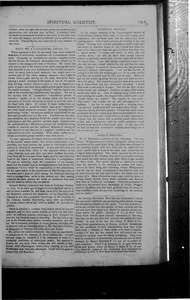< A Strange Adventure (continued from page 3-156) >
await you at the tribunal,” he said. “Go, and tell them to come here; I have a revelation to make them,” I replied, giving a last touch to the face of the assassin, who appeared almost alive and breathing. The jailor left me, and a few minutes later the judges appeared. Trembling from head to foot I pointed to the sketch and said, “Behold the assassin.”
Baron S—— examined it quietly and carefully, and then said, “His name?” “I do not know it,” I replied. “But at this moment he is in the market, cutting up meat, at the third stall on the left, in entering by—— Street.” “What do you think of this?” said my judge to his colleague. “That we ought immediately to send and seek the man,” he replied in a grave tone. He went into the corridor and gave orders to the gendarmes who were there on duty. During their absence, the judges remained standing, looking at the sketch, while I sank on the ground under the weight of my emotion, and remained with my head between my knees.
Soon steps were heard along the corridor. Those who have never awaited the moment of their deliverance, who have never counted the minutes, that seem like centuries; those who have never experienced the poignant emotions of uncertainty and terror, hope anti doubt, cannot realize the intense agony of that moment. I could have distinguished the step of the murderer from among a million. The judges even were moved. I raised my head, but a hand of iron seemed to press upon my heart. My eyes were riveted on the door; it opened, and the man entered. His cheeks were red and puffed, his large jaw was contracted and the muscles swollen even to his ears, his eyes small, black, and restless, sparkled through his red eyelids. Baron S—— silently pointed to the sketch, on perceiving which, the strong sunburnt man became pale as death; he uttered a how that startled us all, opened his arms, sprung back anti rushed out, knocking down his guards. There was a terrible struggle in the corridor; we could hear the panting breath of the butcher, fearful imprecations, interrupted words and stamping of many feet. At last the assassin was dragged into the cell, his head sunk upon his chest, his eyes became bloodshot, and the limbs stiffened. Once more he gazed at the drawing on the wall, appeared to reflect, and murmured “Who then could have seen me at midnight?”
Many years have passed since this terrible adventure. I am thankful to say I no longer dread want, nor am I obliged to make portraits of Burgomasters and old women. The nocturnal drawing has never lost its place in my memory, and I often sit for hours pondering over that strange event. How was it possible that a crime committed by a man utterly unknown to me could have been faithfully represented in its most minute details? Was it by chance? No. Schiller was perchance right in saying, “The immortal soul does not occupy itself with the exhaustion of the body, but spreads its radiant pinions and floats off God knows where. What it then does no one knows, but inspiration betrays from time to time the secret of these nocturnal voyages. Who knows? Nature dares more in reality than imagination in its caprice.”
"Sleeping Stones"
At the regular meeting of the Psychological Society of Great Britain, Enmore Jones said, “I have had twenty years experience, and mediums have told me plenty they knew nothing about. Once I bad a servant girl residing in my own house. Passing over several phenomena which would take me twelve or fourteen hours to tell, I found that when she I was in the clairvoyant state she gave evidence that there was a ‘ghost power’ in stones and shells, or what you call psychic force; ‘she told me there were certain curative powers in particular stones, and that she could tell me where the stones were. I was fool enough sometimes to get a cab, she with her eyes closed entered the cab, and thus we made many journeys in search of stones which she had previously seen at a distance clairvoyantly. I did not like the idea of being in a cab with this sleeping girl, so I lit up a wax candle, and thus we travelled over the hills and far away. When we got out she would jog along with her eyes shut until we arrived at the place. She would then put her hand down and pick up a stone which she had previously described. I would then mark it and wrap it in paper. She told me that certain stones would put mesmeric sensitives to sleep whilst others would wake them up. Once in walking along a road while I was carrying the candle, she stopped with a shock, and I said I ‘Lizzie! what’s the matter?’ She replied, ‘O, that stone! That stone!’ and it woke her up; she had stepped on it in walking. I put her to sleep again with a sleeping stone. Unconscious cerebration will not explain these things. We want less theory and more practice. I found that these stones possessed the same powers over other sensitives which she asserts them to have, and I could tell you of many experiments. I found that the stones had a peculiar power within themselves, and a distinctive color, by which sensitives could identify them when in a clairvoyant state. If any man tells me that unconscious cerebration explains these things, he is not so wise as I am.
Swedenborg
...
The Facts and the Opposition
...
<... continues on page 3-158 >
Editor's notes
Sources
-
Spiritual Scientist, v. 5, No. 15, December 14, 1876, p. 159

